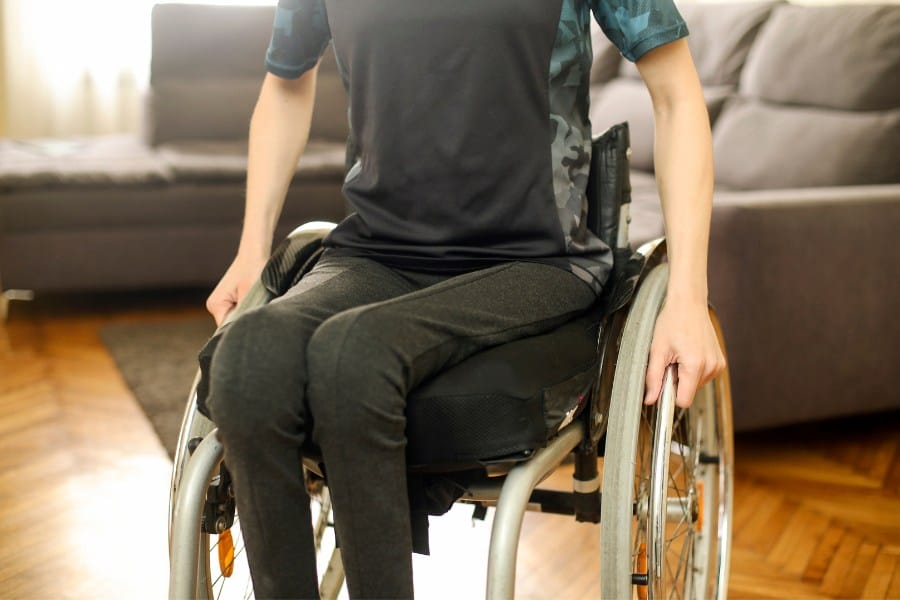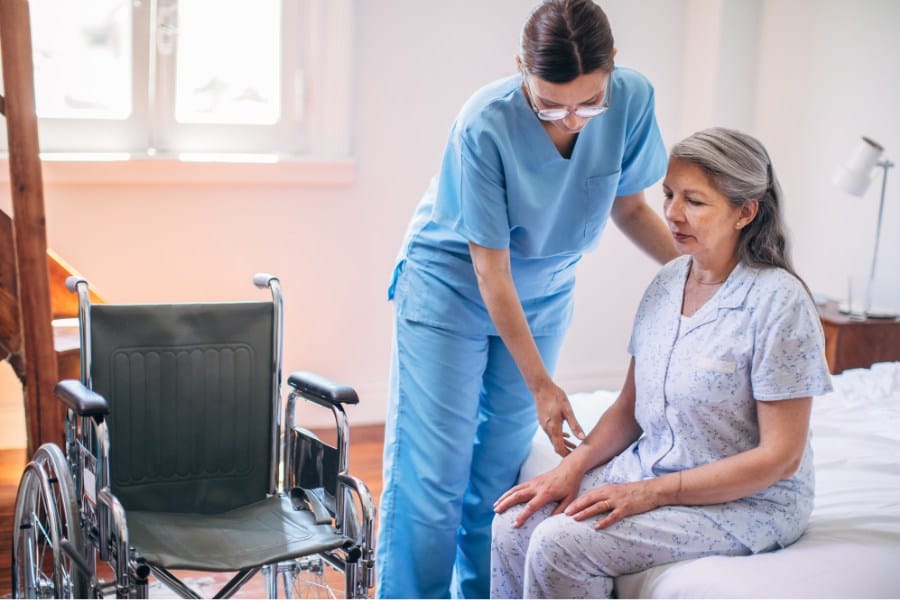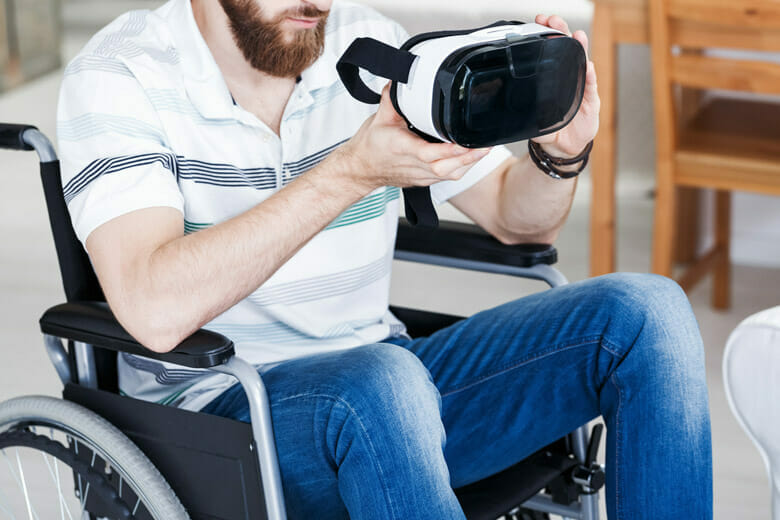Paraplegia is a condition that affects a person’s ability to move their legs and lower body due to damage or injury to the spinal cord.
A common question that arises is whether paraplegics can feel pain. The answer is yes, paraplegics can feel pain, but the type and intensity of pain they experience may differ from those without the condition.
Pain perception in paraplegics can be complex and is influenced by various factors, including the location and severity of the injury, the individual’s mental state, and the presence of other medical conditions.
Some paraplegics may experience neuropathic pain, which is caused by damage to the nerves themselves, while others may experience musculoskeletal pain due to the strain on their muscles and joints from being in a wheelchair or using crutches.
It is important to understand the different types of pain that paraplegics may experience and to manage them effectively to improve their quality of life.
Let’s dive into paraplegia a little further.
Key Takeaways
- Paraplegics can feel pain, but the type and intensity of pain they experience may differ from those without the condition.
- Pain perception in paraplegics can be complex and influenced by various factors, including the location and severity of the injury, the individual’s mental state, and the presence of other medical conditions.
- Effective pain management is crucial in improving the quality of life for paraplegics.
What is Paraplegia?
IN THIS ARTICLE

Paraplegia is a type of paralysis that affects the legs and lower body. It is usually caused by damage to the spinal cord, which is a bundle of nerves that runs from the brain down through the back.
The spinal cord is responsible for transmitting signals between the brain and the rest of the body, so when it is damaged, communication between the brain and the legs can be disrupted, resulting in paralysis.
What Causes Paraplegia?
There are many different causes of paraplegia, including accidents, disease, and trauma. The most common cause of paraplegia is a spinal cord injury, which can occur when the spinal cord is damaged due to an accident or trauma.
Other causes of paraplegia include diseases such as:
- Multiple sclerosis
- Infections
- Tumors.
Types of Paraplegia
There are two main types of paraplegia:
- Complete
- Incomplete.
Complete paraplegia occurs when there is a total loss of sensation and movement below the level of the injury.
In contrast, incomplete paraplegia occurs when there is some sensation and movement below the level of the injury.
Another type of paraplegia is spastic paraplegia, which is characterized by muscle stiffness and spasms. Spastic paraplegia can be caused by a variety of factors, including genetic mutations and infections.
Pain Perception in Paraplegia – Can Paraplegics Feel Pain?

Pain perception in paraplegia is a complex phenomenon.
Paraplegia is a condition that causes partial or complete paralysis of the lower half of the body. It can be caused by various factors, including spinal cord injury, nerve damage, and infections.
Pain perception in paraplegia can be classified into three main categories:
- Neuropathic pain
- Musculoskeletal pain
- Visceral pain.
Neuropathic Pain
Neuropathic pain is a type of pain that is caused by damage to the nerves. It is a common type of pain in paraplegia and can be described as tingling, burning, or shooting pain.
Neuropathic pain can occur above, at, or below the level of the spinal cord injury and can persist for many years after the acute injury. It is found to contribute to reduce the quality of life in patients with paraplegia.
Musculoskeletal Pain
Musculoskeletal pain is a type of pain that is caused by damage to the muscles, joints, or bones. It is a common type of pain in paraplegia and can be described as back pain, joint pain, or pain in the muscles.
Musculoskeletal pain can occur due to the increased motion that is likely to occur just above and just below the fusion. Making an effort to distract oneself can actually help reduce pain and can make one feel better.
Visceral Pain
Visceral pain is a type of pain that is caused by damage to the internal organs. It is a common type of pain in paraplegia and can be caused by bowel infections, constipation, bowel control, and other factors.
Visceral pain can be described as a deep, cramping pain that is often accompanied by a feeling of fullness or pressure.
New Phantom Pain Technology
Scientists at the École Polytechnique Fédérale de Lausanne (EPFL), a research institute in Switzerland, have been studying the use of virtual reality to reduce phantom body pain in paraplegics.
Paraplegia is the impairment of motor or sensory function of the lower extremities. It is often the result of spinal cord injury or a congenital condition. Every year, between 250,000 and 500,000 people suffer a spinal cord injury (SCI). In the United States, more than half of individuals with a SCI are considered paraplegic.
Phantom limb pain refers to painful sensations that seem to come from parts of the body that no longer have feelings or are no longer there. For paraplegics, neuropathic pain is experienced in the legs, even though they have no feeling in the lower extremities.
This pain can be experienced as burning, shooting, twisting, itching, pressure, “pins and needles”, or electrical shocks, and it is resistant to drug therapy.
Virtual reality reduces phantom limb pain in paraplegics by creating the illusion that the paralyzed legs are being touched. In this study, the researchers lightly tapped on the subject’s back either just above the spinal cord lesion (lower back) or near the shoulders (upper back).
Subjects sat down with dummy legs in front of them. Video of the dummy legs was taken from above, as if looking down on one’s own legs, and the video was shown in real-time through virtual reality goggles.
In the experiment, the scientist simultaneously taps the subject’s back and dummy leg. The subject is conscious of the feeling that their back is being tapped, but after a minute, the illusion takes place. The visual stimulus is stronger than the tactile stimulus, and the subject experiences the feeling that their own legs are being tapped.
In total, there were twenty patients with paraplegia from SCI and twenty healthy control participants. Results demonstrated that the virtual leg illusion was associated with mild analgesia, which is the inability to feel pain.
Restoring a sense of touch is key to alleviating the phantom pain experienced by paraplegics. In this instance, the researchers successfully manipulated the brain-body relationship to alleviate pain.
Researchers and technologists are working together to develop digital therapy further for individuals with spinal cord injuries and other chronic pain issues for at-home use.
Managing Pain and Complications

Paraplegia can cause a variety of complications, including pain and discomfort. However, there are several ways to manage these symptoms and prevent further complications.
Medical Interventions
There are several medical interventions that can help manage pain and prevent further complications in paraplegics. Medications such as pain relievers, muscle relaxants, and anti-spasticity drugs can help alleviate pain and discomfort.
Spinal cord stimulation is another effective medical intervention that can help manage pain. This procedure involves the use of electrical impulses to block pain signals from reaching the brain.
In some cases, surgery may be necessary to address complications such as pressure sores or spinal cord compression. However, surgery is typically reserved for severe cases and is not always necessary.
Rehabilitation and Therapy
Physical therapy and occupational therapy are essential components of managing pain and complications in paraplegics.
Physical therapy can help improve mobility, strength, and flexibility, while occupational therapy can help individuals regain independence and improve their quality of life. Exercise and stretching are also important components of rehabilitation and can help prevent further complications.
In addition to traditional therapies, alternative therapies such as acupuncture and massage may also be effective in managing pain and discomfort. However, it is important to consult with a healthcare professional before starting any new therapy or treatment.
Lifestyle and Coping Strategies
Lifestyle and coping strategies can also play an important role in managing pain and complications associated with paraplegia.
Maintaining a healthy lifestyle through proper nutrition and regular exercise can help prevent complications such as deep vein thrombosis and improve overall well-being.
Psychological support through psychotherapy or support groups can also be helpful in managing depression, anxiety, and other mental health concerns.
Motivation and a positive attitude are also important factors in managing pain and achieving independence.
Get Home Nursing Care Today
If you or a loved one are paraplegic, a private nurse can help. NurseRegistry offers industry-leading scheduling flexibility to ensure you receive a nurse exactly when and where you need them. We even provide 24/7 around-the-clock care.
We have over 500 empathetic and experienced nurses who can assist with activities of everyday living, medication management, and assisting with physical therapy.
Additionally, nurses can provide exceptional companionship. Click below to learn more ways that NurseRegistry can assist you today.
Frequently Asked Questions about Paraplegics
What types of pain can individuals with paraplegia experience?
Individuals with paraplegia can experience different types of pain, such as nerve pain, muscle pain, and joint pain. Nerve pain is a common type of pain experienced by individuals with spinal cord injuries. It is often described as a burning, tingling, or shooting severe pain, and it can be difficult to manage.
How is nerve pain managed in patients with spinal cord injuries?
Nerve pain in patients with spinal cord injuries can be managed with medications such as anticonvulsants, antidepressants, and opioids. Non-pharmacological interventions such as physical therapy, acupuncture, and nerve stimulation can also be effective in managing nerve pain.
Are there specific treatments for pain below the level of spinal cord injury?
There are no specific treatments for pain below the level of spinal cord injury for people with paraplegia. However, medications and other interventions can be effective in managing pain in these areas.
What are the common causes of pain in paraplegic patients?
The common causes of pain in paraplegic patients include nerve damage, muscle spasms, pressure sores, and joint pain. These can be caused by a variety of factors, including injury, disease, and lifestyle factors.
How does paraplegia affect sensory perception and pain sensation?
Paraplegia can affect sensory perception and pain sensation by causing changes in the way the nervous system functions. Individuals with paraplegia may experience altered or reduced sensation, as well as changes in the way they perceive pain.
Can individuals with paraplegia experience phantom limb pain?
Phantom limb pain is a type of pain that is experienced in a limb that has been amputated. Individuals with paraplegia do not experience phantom limb pain, as they have not undergone limb amputation.
What do paralyzed people feel?
Paralyzed people can feel different sensations depending on the severity and location of their injury. They may experience altered or reduced sensation, as well as changes in the way they perceive pain.
What can paraplegics not do?
Paraplegics may have difficulty with activities that require full use of their legs, such as walking, running, and jumping. However, with the right equipment and support, they can participate in many other activities and lead fulfilling lives.
Sources
Pozeg, Polona, et al. “Virtual Reality Improves Embodiment and Neuropathic Pain Caused by Spinal Cord Injury.” Neurology, 6 Oct. 2017, doi:10.1212/wnl.0000000000004585
staff, Science X. “Virtual Reality Reduces Phantom Pain in Paraplegics.” Medical Xpress, Medical Xpress, 30 Oct. 2017, medicalxpress.com/news/2017-10-virtual-reality-phantom-pain-paraplegics.html
“Paraplegia.” Wikipedia, Wikimedia Foundation, 20 Oct. 2017, en.wikipedia.org/wiki/Paraplegia
“Spinal Cord Injury Facts & Statistics.” SCI – Info – Pages, www.sci-info-pages.com/facts.html
“Spinal Cord Injury.” World Health Organization, World Health Organization, Nov. 2013, www.who.int/mediacentre/factsheets/fs384/en/
“What Is Phantom Limb Pain?” WebMD, WebMD, www.webmd.com/pain-management/guide/phantom-limb-pain#1
“Managing Phantom Pain.” Amputee Coalition, www.amputee-coalition.org/limb-loss-resource-center/resources-for-pain-management/managing-phantom-pain/






